Asynchronous processing of sparse signals
March 19, 2014
Unlike synchronous processing, low–power asynchronous processing is more efficient in biomedical and sensing networks applications as it it is free from aliasing constraints and quantization error in the amplitude, it allows continuous–time processing and more importantly data is only acquired in significant parts of the signal. In this paper, we consider signal decomposers based on the asynchronous sigma delta modulator (ASDM), a non–linear feedback system that maps the signal amplitude into the zero–crossings of a binary output signal. The input, the zero–crossings and the ASDM parameters are related by an integral equation making the signal reconstruction difficult to implement. Modifying the model for the ASDM, we obtain a recursive equation that permits to obtain the non–uniform samples from the zero–time crossing values. Latticing the joint time–frequency space into defined frequency bands, and time windows depending on the scale parameter different decompositions, similar to wavelet decompositions, are possible. We present two cascade low– and high–frequency decomposers, and a bank–of–filters parallel decomposer. This last decomposer using the modified ASDM behaves like a asynchronous analog to digital converter, and using an interpolator based on Prolate Spheroidal Wave functions allows reconstruction of the original signal. The asynchronous approaches proposed here are well suited for processing signals sparse in time, and for low–power applications. The different approaches are illustrated using synthetic and actual signals.
This material is presented to ensure timely dissemination of scholarly and technical work. Copyright and all rights therein are retained by authors or by other copyright holders. All persons copying this information are expected to adhere to the terms and constraints invoked by each author’s copyright. In most cases, these works may not be reposted without the explicit permission of the copyright holder.



